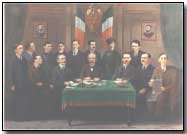 Drawing of Cúchulainn by John Duncan, Scottish 19th C. artist
Drawing of Cúchulainn by John Duncan, Scottish 19th C. artistI am taking a turn here to start from the beginning of Irish History and its heroes. There are many heroes of Irish History, not just the ones from 1916. Ireland was not always in the possession of foriegn invaders. Some of the wars were internal.
Cúchulainn (pronounced koo hool n) is an Irish mythological hero who appears in the stories of the Ulster Cycle, as well as in Scottish and Manx folklore. The son of the god Lug and Deichtine (sister of Conchobar mac Nessa), he was originally named Sétanta.
Cúchulainn (pronounced koo hool n) is an Irish mythological hero who appears in the stories of the Ulster Cycle, as well as in Scottish and Manx folklore. The son of the god Lug and Deichtine (sister of Conchobar mac Nessa), he was originally named Sétanta.
He gained his better-known name as a child after he killed Culann's fierce guard-dog in self-defense, and offered to take its place until a replacement could be reared. At the age of seventeen he defended Ulster single-handedly against the armies of queen Medb of Connacht in the epic Táin Bó Cúailnge ("Cattle Raid of Cooley"). It was prophesied that his great deeds would give him everlasting fame, but that his life would be short–one reason he is compared to the Greek hero Achilles.
He is known for his terrifying battle frenzy or ríastrad (similar to a berzerker's frenzy, though sometimes called a "warp spasm" because of the physical changes that take place in the warrior), in which he becomes an unrecognisable monster who knows neither friend nor foe. He fights from his chariot, driven by his loyal charioteer Láeg, and drawn by his horses, Liath Macha and Dub Sainglend. In more modern times, Cú Chulainn is often referred to as the "Hound of Ulster".

No comments:
Post a Comment